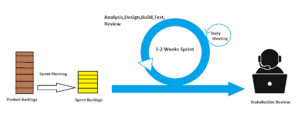Agile:
Agile is the simplest and effective way for a business to scope into a software solution. The Agile practice promotes continuous iteration, learning, progressive development, enhancement, and early delivery. Agile methodologies have an iterative manner to handle a variety of planning management handling projects. The agile development methods are used in 80% of all software development projects.
Most of the team Choose Agile because it is easy to get responses or feedback from customers quickly, it eliminates delay, reduces time consumption & expenditure, provides multiple opportunities for stakeholder and team engagement – each Sprint progress. Agile development has time-boxed project cycles known as Sprint. A Sprint has a short period of time, teams work on a small feature called “User stories”, which are extracted from “Product Backlogs”.
Next iteration planning has to be taken for New or changed backlog items, providing the chance to introduce changes within a few weeks. Agile has a unique option for clients to be involved throughout the estimation, from prioritizing highlights to iteration planning and review sessions to frequent software builds containing new enhancements. Limiting features are more manageable in the development and release phases. Daily status meetings define the transparency of the project status; it highlights issues and addresses them quickly.
Key Agile methodologies
1. Scrum
2. Extreme Programming(XP)
3. Adaptive Software Development(ASD)
4. Dynamic Software Development Method(DSDM)
5. Feature Driver Development
6. Kanban
7. Behaviour Driver Development(BDD)
The Agile Manifesto indicates the technological revolution to find a solution for the problem forever. It helps the team to work more efficiently and sustainably.
-Iteration & Individuals over process and tools
-Working software over comprehensive documentation
-Customer collaboration over contract negotiation
-Responding to change over following a plan
12 Principles of Agile
1. Customer satisfaction through early and continuous delivery of the product
2. Accepting and encouraging Changing Requirement even though late in development, it manipulates change for the customer’s advantage
3. Practice continuous delivery of a working product within a shorter timescale
4. All stakeholders and development team must work together to ensure that the project is going in the correct direction
5. Shape a supportive environment to motivate individuals and strengthen them to get the job done
6. Most effective and preferable way of communication is face-to-face
7. Working software application is the key measure of progress
8. Everyone should emulate a sustainable constant pace of development.
9. Sustain the quality of the product by concentrating on technical details
10. Maintaining simplicity is essential.
11. Encourage self-organization to generate the most value
12. Continuous improvement regularly reflects on company performance
Benefits of Agile
Agile helps to manage work more successfully during the highest quality within the limitation of the budget. Agile Method is an approach to help the development team manage projects efficiently, address the moving target and specify the new forming of new software applications it also prioritizes relationships, even in regulated industries or process-heavy environments

Continuous improvement and delivery of helpful software for customers’ needs to find responsive vendors for development requests. Increasing efficiency of the software, vendors focusing success effort on high-value features. Reduce wastage of the products and decrease overhead.
DevOps
DevOps is a collaboration of “Development” and ” Operations”; the word “DevOps” is derived from the words “Developers” and “Operations” team together. The ultimate goal of DevOps is to help the organization speed up delivering software to the end-user and collect feedback from them and work on it.
A successful DevOps enterprise requires extraordinary collaboration between Multiple teams. The research report shows the Worldwide DevOps software market is expected to grow from USD 2.90 Billion in 2017 to USD 10.31 Billion by 2023 in the future. It tracks and analyzes competing developments, mergers and recovery, new product agreements, and collaborations in the DevOps Market.
How does it work?
DevOps Practice of operational and development teams work together in the entire project lifecycle and innovate solutions to satisfy customers’ needs. DevOps workflow consists of a layer of phases like planning, building, testing & deploying, delivering, monitoring, and collecting customer feedback. Most organizations use DevOps to speed and improve development, while some use software development methodologies and practices like Scrum, Kanban, and Agile.
Key practices of DevOps
Configuration Management defines the process by which all environments providing software are configured and maintained, ensuring that territory is most advantageous. The chief components that comprise comprehensive configuration management are Artifact repository, Source code repository, and Database for Configuration Management.
Continuous Integration is the process where developers combine the new code that has been written more frequently throughout the application progress cycle, adding it to the code base at the main repository and running the tests automatically for every new commit pushed at least it helps avoid problems at the final merge for the release.
Automated Testing is an addition of technology that performs tasks with reduced human assistance and facilitates feedback loops between operations and development teams, aiming to deliver high-quality product releases and update
Infrastructure as Code(Iac) is a managing cluster of networks, virtual machines, data centers, load balancers, and connection topology in a descriptive model. IaC produces the same environment for continuous delivery with help of source code. IaC practices assist in implementing cloud monitoring, logging, and altering tools for some environments.
Continuous Delivery has become an essential ingredient for teams doing iterative and incremental software delivery. value has become a mandatory requirement for organizations. The services should be delivered to the customers without errors.
Continuous Deployment helps in automatically deploying code and validates new ideas for businesses to respond to changing market demands.CD builds an application as defect-free from validating and monitoring the software from customer feedback and rollback from risk failure.
Continuous Monitoring process to monitor and identify compliance issues and security risks. This enables the timely reaction to a security warning, reducing damage and allowing faster restoration of the system to excellent operational levels.
Benefits of DevOps
1. Ensure Faster deployment
2. Reduce Defect density
3. Economical deliverable and Continuous release
4. Improved operational support and faster fixes
5. Good collaboration processes between teams
6. Increased team flexibility and agility
Summary:
The Agile and DevOps process provides stabilized work velocity, greater acceleration, and the capacity to have new opportunities and deliver more value. The report says 75% of organizations have improved business goals and customer satisfaction when using agile with DevOps.









